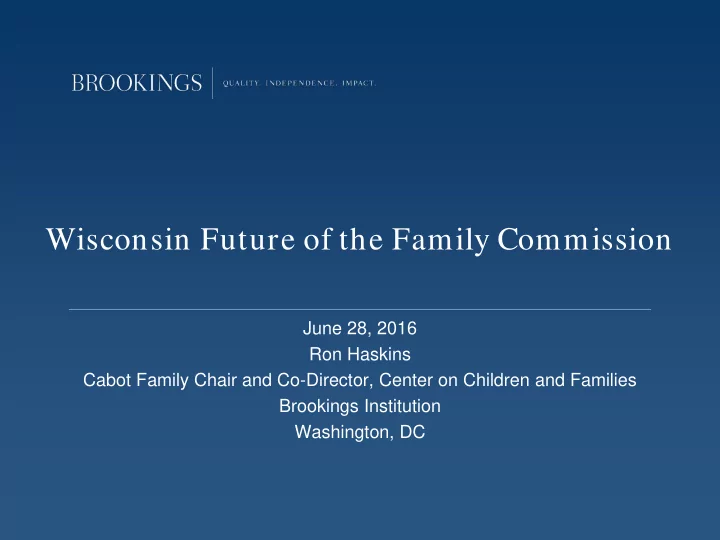

Wisconsin Future of the Family Commission June 28, 2016 Ron Haskins Cabot Family Chair and Co-Director, Center on Children and Families Brookings Institution Washington, DC
2 Changes in Women’s Family Structure at Age 35, 1970-2010 100 5.7 6.9 9.2 9.9 9.7 7.0 90 10.2 9.3 15.8 17.4 18.6 80 14.2 70 Percent of Women 15.0 16.3 20.5 60 Married without children 50 Single without children Single with children 40 78.1 Married with children 68.7 30 59.3 57.0 51.1 20 10 0 1970 1980 1990 2000 2010 Year Source: Author's calculations from the decennial census (U.S. Bureau of the Census 1970, 1980, 1990, 2000) and the American Community Survey (U.S. Bureau of the Census 2010)
3 Employment-to-Population Ratio for Selected Populations, 1980-2013 80 72.0 Employment-Population Ratio (Percent) 70 All Men 64.4 60.9 60 59.4 53.2 Never- 47.7 50 Married 49.6 Mothers 40 All 39.9 Women 30 20 Black Men, Ages 10 20-24 0 1980 1983 1986 1989 1992 1995 1998 2001 2004 2007 2010 2013 Year Source: Annual Social and Economic Supplement to the CPS, 1980-2013.
4 Median Family I ncome of Adults Age 30-39 by Education Level, 1964-2014 $140,000 $119,714 $120,000 Advanced Median Family Income degree $100,000 $89,261 Bachelor's degree $80,000 Some college $57,550 $60,000 High school degree $49,642 $40,000 Less than high school $32,171 $20,000 $0 1964 1969 1974 1979 1984 1989 1994 1999 2004 2009 2014 Year Source: Census' Annual Social and Economic Supplement to the Current Population Survey. Inflation adjusted using PCE deflator. Note: The CPS changed the phrasing of the educational attainment question in 1992, which accounts for that year's sudden drop among the less-than-high-school group.
5 Summary Trends in family composition, employment, and education are moving in the wrong direction for reducing poverty and increasing economic mobility
6 Best Bet # 1: The Most Successful Way to Reduce Poverty: Combine Work and Work Supports 60% 50% 48% 40% Poverty Rate 38% 34% 30% 29% 24% Earned Income Only 20% Plus Cash benefits outside the tax system (UI, child support, SSI, AFDC, TANF, GA) i.e. "the official poverty rate" Plus Food Stamps/SNAP 10% Plus EITC & ACTC, less FICA & federal & state income taxes Plus Stimulus/recovery payments & income from other houshold members 0% 1987 1989 1991 1993 1995 1997 1999 2001 2003 2005 2007 2009 2011 2013 Year Note: Abbreviations are as follows: Unemployment Insurance (UI), Supplemental Security Income (SSI), Aid to Families with Dependent Children (AFDC), Temporary Assistance for Needy Families (TANF), Government Assistance (GA), Supplemental Nutrition Assistance Program (SNAP), Earned Income Tax Credit (EITC), Additional Child Tax Credit (ACTC), and Federal Insurance Contributions Act (FICA). Source: Thomas Gabe, Congressional Research Service, Welfare, Work, and Poverty Status of Female-Headed Families with Children: 1987-2013 .
7 Best Bet # 2: Family Stability (Birth Control)
8 Potential Benefits of Reducing Unplanned Pregnancies Reduced poverty rates • Lower abortion rates • Better spacing of babies • Increased likelihood of prenatal care • • Less postpartum depression Reduced partner separation rates • More education for mothers • Cost savings for government • Source: National Campaign to Prevent Teen and Unplanned Pregnancy, 2014.
9 St Louis: The CHOI CE Project Women using LARCs or shots had lowest unintended pregnancy rates after 1, 2, and 3 years Source: http://www.choiceproject.wustl.edu/~/media/Files/ChoiceProject/Study-Findings-20120917.ashx.
10 Best Bet # 3: Skilled Employment • 4-year colleges (college prep programs) • 2-year colleges • Apprenticeships • Certificates & Licenses • Career Academies • Goal: Prepare kids for skilled jobs available in the local economy
11 Best Bet # 4: Early Childhood Education • Programs: Home Visiting Head Start State pre-K Child Care • Spending about $25 billion per year (federal & state) • Quality Is the Key • State and Local Governments Have to Step Up
Recommend
More recommend